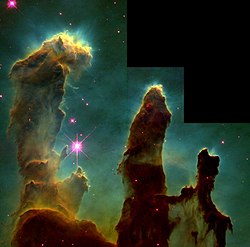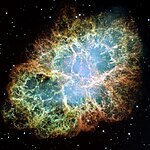NOTE: This Page Contains informations about Nebulas not clouds


A nebula (from Latin: "cloud" [1]; pl. nebulae or nebulæ, with ligature or nebulas) is an interstellar cloud of dust, hydrogen gas, helium gas and plasma. Originally nebula was a general name for any extended astronomical object, including galaxies beyond the Milky Way (some examples of the older usage survive; for example, the Andromeda Galaxy was referred to as the Andromeda Nebula before galaxies were discovered by Edwin Hubble). Nebulae often form star-forming regions, such as in the Eagle Nebula. This nebula is depicted in one of NASA's most famous images, the "Pillars of Creation". In these regions the formations of gas, dust and other materials "clump" together to form larger masses, which attract further matter, and eventually will become big enough to form stars. The remaining materials are then believed to form planets, and other planetary system objects.
Formation

Many nebulae form from the gravitational collapse of gas in the interstellar medium or ISM. As the material collapses under its own weight, massive stars may form in the center, and their ultraviolet radiation ionises the surrounding gas, which creates plasma, making it visible at optical wavelengths. An example of this type of nebula is the Rosette Nebula or the Pelican Nebula. The size of these nebulae, known as HII regions, varies depending on the size of the original cloud of gas, and the number of stars formed can vary too. As the sites of star formation, the formed stars are sometimes known as a young, loose cluster. Some nebulae are formed as the result of supernova explosions, the death throes of massive, short-lived stars. The material thrown off from the supernova explosion is ionized by the supernova remnant. One of the best examples of this is the Crab Nebula, in Taurus. It is the result of a recorded supernova, SN 1054, in the year 1054 and at the centre of the nebula is a neutron star, created during the explosion.
Other nebulae may form as planetary nebulae. This is the final stage of a low-mass star's life, like Earth's Sun. Stars with a mass up to 8-10 solar masses evolve into red giants and slowly lose their outer layers during pulsations in their atmospheres. When a star has lost a sufficient amount of material, its temperature increases and the ultraviolet radiation it emits is capable of ionizing the surrounding nebula that it has thrown off. It is 97% Hydrogen and 3% Helium. The main goal in this stage is to achieve equilibrium
Diffuse nebulae
Most nebulae can be described as diffuse nebulae, which means that they are extended and contain no well-defined boundaries.[1] In visible light these nebulae may be divided into emission nebulae and reflection nebulae, a categorization that depends on how the light we see is created. Emission nebulae contain ionized gas (mostly ionized hydrogen) that produces spectral line emission.[2] These emission nebulae are often called HII regions; the term "HII" is used in professional astronomy to refer to ionized hydrogen. In contrast to emission nebulae, reflection nebulae do not produce significant amounts of visible light by themselves but instead reflect light from nearby stars.[2]
Dark nebulae are similar to diffuse nebulae, but they are not seen by their emitted or reflected light. Instead, they are seen as dark clouds in front of more distant stars or in front of emission nebulae.[2]
Although these nebulae appear different at optical wavelengths, they all appear to be bright sources of emission at infrared wavelengths. This emission comes primarily from the dust within the nebulae.[2]
Specific types of nebulae
While diffuse nebulae have poorly-defined boundaries, a few nebulae may actually be described as discrete objects with identifiable boundaries.
Planetary nebulae
Planetary nebulae are nebulae that form from the gaseous shells that are ejected from low-mass asymptotic giant branch stars when they transform into white dwarfs.[2] These nebulae are emission nebulae with spectral emission that is similar to the emission nebulae found in star formation regions.[2] Technically, they are a type of HII region because the majority of hydrogen will be ionized. However, planetary nebulae are denser and more compact than the emission nebulae in star formation regions.[2] Planetary nebulae are so called because the first astronomers who observed these objects thought that the nebulae resembled the disks of planets, although they are not at all related to planets.[3]
Protoplanetary nebula
A protoplanetary nebula (PPN) is an astronomical object which is at the short-lived episode during a star's rapid stellar evolution between the late asymptotic giant branch (LAGB) phase and the subsequent planetary nebula (PN) phase.[4] A PPN emits strong infrared radiation, and is a kind of reflection nebula. The exact point when a PPN becomes a planetary nebula (PN) is defined by the temperature of the central star.
Supernova remnants
A supernova occurs when a high-mass star reaches the end of its life. When nuclear fusion ceases in the core of the star, the star collapses inward on itself. The gas falling inward either rebounds or gets so strongly heated that it expands outwards from the core, thus causing the star to explode.[2] The expanding shell of gas form a supernova remnant, a special type of diffuse nebula.[2] Although much of the optical and X-ray emission from supernova remnants originates from ionized gas, a substantial amount of the radio emission is a form of non-thermal emission called synchrotron emission.[2] This emission originates from high-velocity electrons oscillating within magnetic fields.
Notable named nebulae
- Ant Nebula
- Barnard's Loop
- Boomerang Nebula
- Cat's Eye Nebula
- Crab Nebula
- Eagle Nebula
- Eskimo Nebula
- Eta Carinae Nebula
- Hourglass Nebula
- Horsehead Nebula
- Orion Nebula
- Pelican Nebula
- Red Square Nebula
- Ring Nebula
- Rosette Nebula
- Tarantula Nebula






0 comments:
Post a Comment